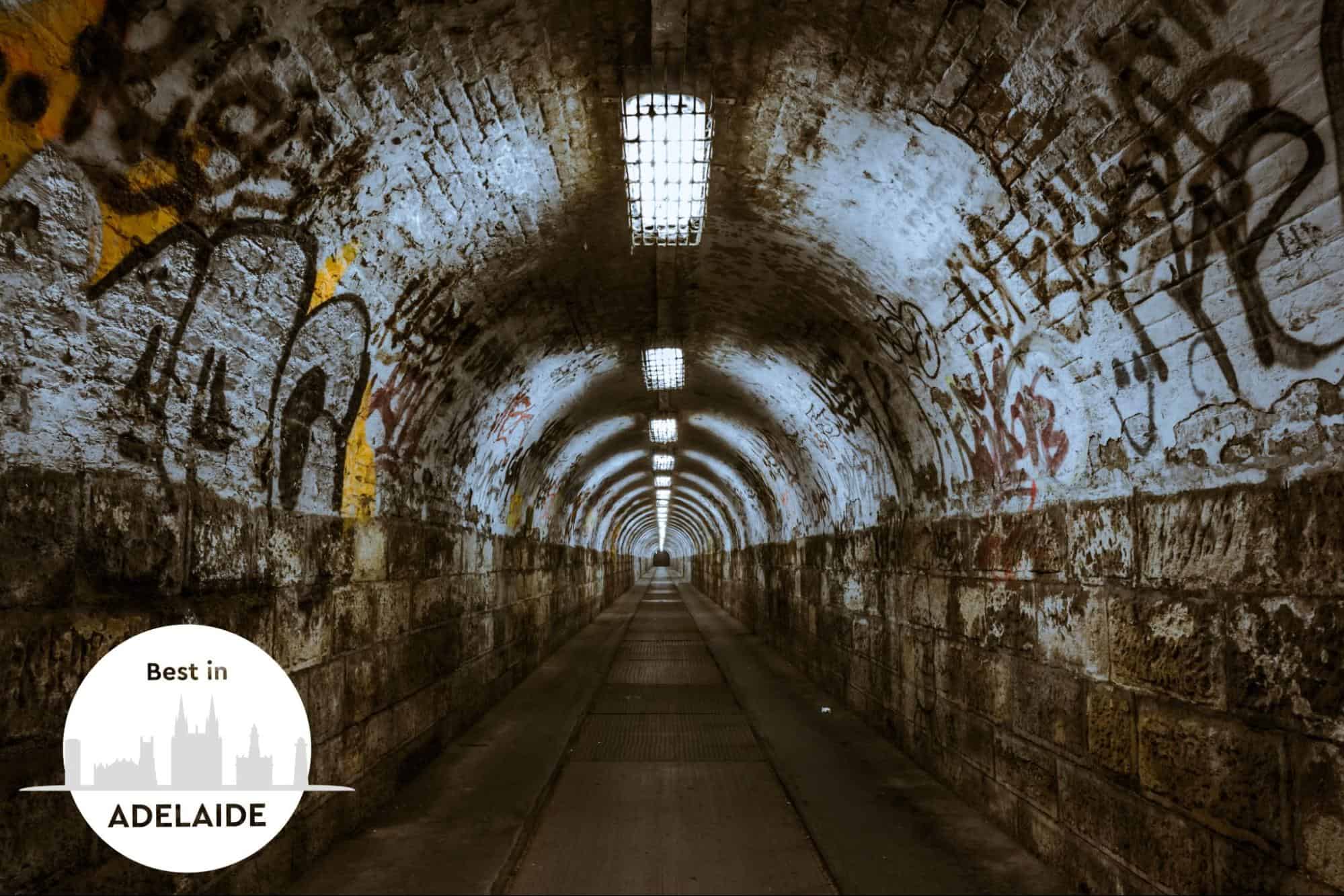
Unearthing Adelaide’s Underground Bunkers and Tunnels
- Adelaide’s Underground Bunkers and Their Histories
- RAAF Edinburgh Semi-Underground Bunkers
- Cracking the Cipher
- The Battles Influenced by Interceptors of the RAAF Edinburgh Semi-Underground Bunkers
- The Underground Communications Bunker
- The Establishment of WAAAF
- After the War
- Adelaide’s Fallout Shelters
- Adelaide’s Underground Tunnels and their Histories
- Adelaide Treasury Tunnels
The City of Adelaide holds a clandestine and historic underground world, from enigmatic WW2 underground bunkers to the shadowy vaults beneath the Old Treasury Building.
Our intrepid team navigated these subterranean labyrinths, piecing together tales of the past. Read about our escapade and the secrets we unveiled!
Adelaide’s Underground Bunkers and Their Histories
RAAF Edinburgh Semi-Underground Bunkers

Address: Edinburgh Rd, Edinburgh, SA 5111
Contact Details: 1300 333 362
RAAF Edinburgh Semi-Underground Bunkers are a series of covert military facilities located near Edinburgh and were primarily utilized during WW2 by Australians to gain an edge over the Axis forces in the Pacific war theater.
The bunkers have advanced security features for their time and were built partially below ground level, contributing to their distinctive appearance. The Royal Australian Air Force (RAAF) originally built these structures to safeguard personnel equipment.
Its central purpose evolved into concealing sensitive information from Japanese forces who intercepted military communications, leading to a tactical disadvantage for the Allies.
Cracking the Cipher
The bunkers also became the headquarters of Australian interceptors, whose duty was deciphering the Japanese Morse code or kana code and their other encrypted messages.
Initially, the task seemed impossible due to critical cryptographic changes, leading to severe losses for the Allies during the Battle of the Savo Islands.
However, the tides of war in the South Pacific changed when Australian forces discovered high-grade code manuals of the Japanese in the Papua New Guinean city of Sio after a successful siege of the said territory.
The interceptors used the code manuals to finally break the enemies’ code, offering essential insights into Japanese strategies, movements, and plans.
After the war, most of the bunkers were demolished, vandalized, and forgotten. A few were transformed into living spaces.
The Battles Influenced by Interceptors of the RAAF Edinburgh Semi-Underground Bunkers
- Battle of the Coral Sea (1942): Decoded messages allowed Allied forces to anticipate Japanese plans for an attack on Port Moresby, enabling them to counter effectively.
The resultant battle marked a strategic victory, as the Allies prevented the Japanese from advancing further south.
- Battle of Midway (1942): Intelligence gained from decrypted Japanese communications allowed the Allies to predict the Japanese attack on Midway Island.
Armed with this information, the US Navy positioned its forces strategically and decisively defeated the Japanese fleet, turning the tide of the Pacific War.
The Underground Communications Bunker

Constructed in 1944, Adelaide’s most substantial covert communications hub, known colloquially as The Underground Communications Bunker or Doomsday Bunker, was ingeniously designed as an underground facility resembling a Nissen hut.
The bunker spans an impressive length of over 45 meters and boasts a towering height of 10 meters.
This facility served a dual purpose. It primarily facilitated and secured confidential communications, transmitting vital military operations information.
In addition to its communications function, the government designed this bunker as a bomb shelter. The Underground Communications Bunker endured the impact of various weaponry deployed by the Japanese military, even in the event of direct bombings.
The Establishment of WAAAF
The Women’s Auxiliary Australian Air Force (WAAAF) was a significant development in Australia’s military landscape during WW2.
Established in March 1941, it marked a pivotal moment when women were formally incorporated into the Australian Air Force’s operational framework.
This groundbreaking move emerged as a response to the war’s escalating demands. Australia lacked telegraphists due to conscription, necessitating the utilization of women’s skills and efforts to support the nation’s defense.
Over 27,000 members of the WAAAF operated in The Underground Communications Bunker and other Adelaidean bunkers. They undertook essential tasks related to communication operations, administrative duties, and technical support.
After the War
In the post-war era, the demand for food and agricultural products was on the rise, and innovative methods of cultivation were explored to meet these needs.
The Underground bunker, with its controlled environment, adequate space, and robust construction, proved to be an ideal location for growing mushrooms.
Adelaide’s Fallout Shelters

During the Cold War era, the threat of nuclear conflict gave rise to the construction of family fallout shelters in Adelaide.
These family fallout shelters were typically built in backyards or residential properties. They were constructed using reinforced concrete, brick, and even repurposed shipping containers.
The prevailing anxiety over nuclear warfare was amplified by UK’s nuclear tests conducted in Australia during the 1960s and 1970s.
These destructive tests, which took place in remote areas of the country, fueled concerns about potential fallout reaching populated regions, including Adelaide.
Adelaide’s Underground Tunnels and their Histories
Adelaide Treasury Tunnels
Address: 2 Flinders St, Adelaide, SA 5000
Contact Details: (08) 8202 9200
The Adelaide Treasury Tunnels are a historic underground network located beneath the city of Adelaide. Originally constructed in 1839 as storage areas for valuable goods and supplies, they were repurposed for various functions over time.
The tunnels served as secure repositories during the Gold Rush era, functioning as storage vaults for government documents, gold, and other valuable items.
They were part of the State Treasury complex, which included the old Colonial Treasury Building above ground. As Adelaide’s urban landscape evolved, the tunnels found new uses; they were used as air-raid shelters during World War II.
Today, the Adelaide Treasury Tunnels is a popular tourist attraction and a window into the city’s past.
Guided tours offer visitors a chance to explore the underground passages, learning about their history, architecture, and the roles they played in different periods. ___________________________________________________________________





